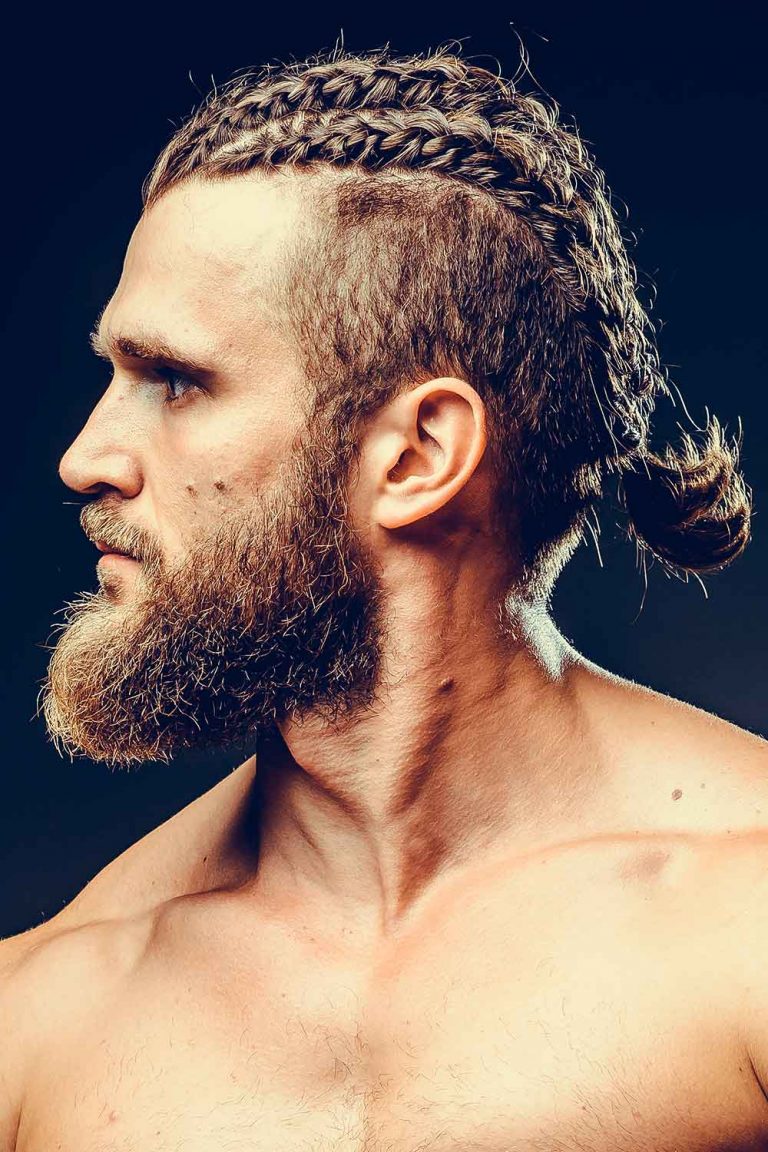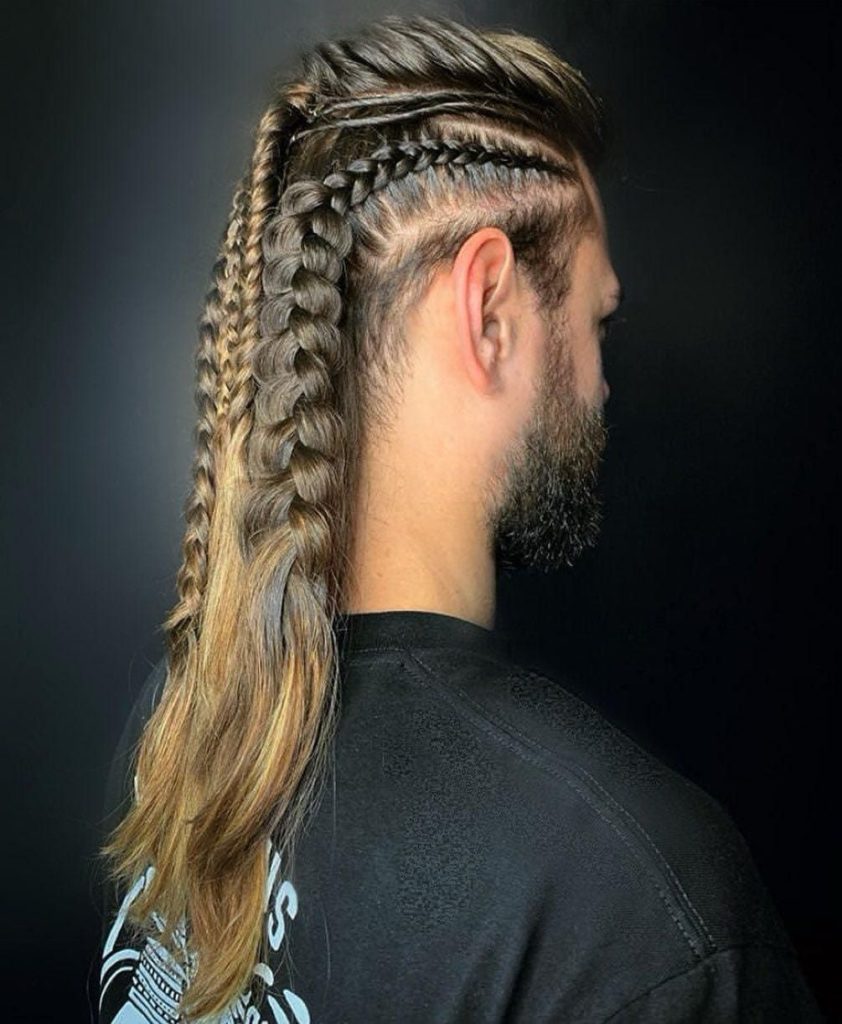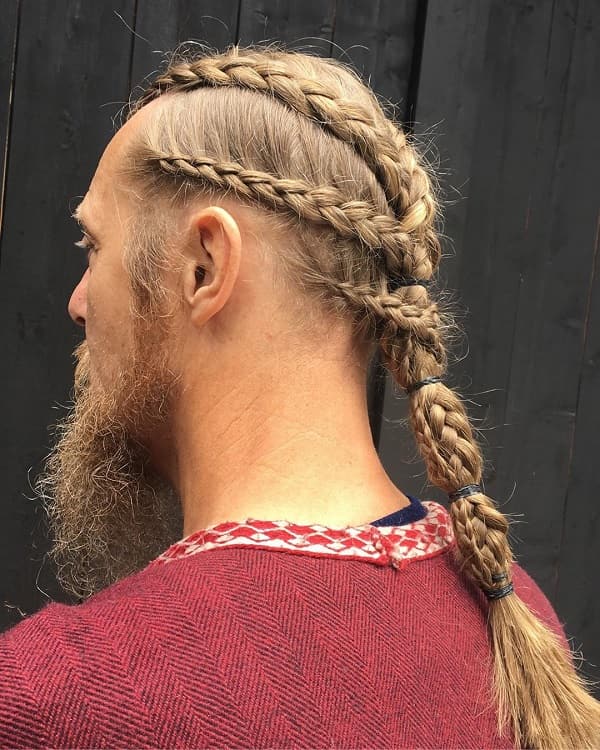Unleashing The Warrior Within: The Enduring Appeal Of Viking Braids For Men
Table of Contents
- The Roots of the Trend: Understanding the Viking Age
- The Allure of Viking Braids for Men Today
- Types of Viking Braids for Men
- Maintaining Your Viking Braids: Care and Styling Tips
- Beyond the Braid: The Broader Impact of Viking Culture
- Debunking Myths About Viking Hair
- Embracing the Spirit: Why Viking Braids Endure
The Roots of the Trend: Understanding the Viking Age
To truly appreciate the modern appeal of viking braids men, one must first delve into the historical context from which they emerged. The term "Viking" itself conjures images of powerful seafarers, but their history is far more complex and nuanced than simple raiding. Understanding their society, values, and daily life provides crucial insight into why certain hairstyles, including braids, were so prevalent and significant.Who Were the Vikings?
The Vikings were members of the Scandinavian seafaring warriors who raided and colonized wide areas of Europe from the 9th to the 11th century, profoundly influencing the continent. These remarkable people hailed from the Scandinavian countries, which include Norway, Sweden, and Denmark. From the 8th to the 11th centuries, a vast number of Scandinavians left their homelands to seek their fortunes elsewhere. These seafaring warriors, known collectively as Norsemen, conducted raids into Europe and beyond, eventually becoming known as Vikings—a name possibly derived from a place called Viken. The Viking Age began dramatically in the year 793 with a notorious attack on the Lindisfarne monastery in England, marking the first known Viking raid. Expert sailors and navigators of their characteristic longships, Vikings established Norse settlements and governments in the British Isles, the Faroe Islands, Iceland, and Greenland. Their disruptive influence profoundly shaped the course of European history, leaving behind a legacy of exploration, trade, and cultural exchange that extended far beyond mere conflict. The key events of the Viking Age, from the first raids in the late 700s to the decline of Norse power, including major battles, exploration, and the lasting impact of Viking culture, continue to be studied and admired.The Significance of Hair in Viking Culture
For the Vikings, hair was not just an aesthetic feature; it was deeply intertwined with their identity, social status, and even spiritual beliefs. Contrary to popular misconceptions of unkempt barbarians, historical evidence suggests that Vikings were remarkably fastidious about their appearance and hygiene. Archaeological findings, including combs, tweezers, and ear spoons, indicate a strong emphasis on personal grooming. Long hair, often braided, was a common sight among Viking men, symbolizing strength, masculinity, and a connection to their ancestral heritage. Braids, in particular, offered practical advantages for warriors. They kept hair out of the way during battle, preventing it from obscuring vision or getting snagged. Beyond practicality, braids could also signify status or allegiance. Intricate braiding patterns might have been a display of wealth or skill, or perhaps even a form of spiritual protection. The act of braiding itself could have been a communal activity, fostering bonds within families or warrior groups. The dedication to maintaining well-groomed hair, often long and styled, reinforces the image of the Viking as a proud and self-respecting individual, a far cry from the wild, dishevelled stereotypes.The Allure of Viking Braids for Men Today
The modern resurgence of "viking braids men" is a testament to the enduring power of historical aesthetics and the influence of popular culture. What was once a practical and symbolic hairstyle for ancient warriors has transformed into a powerful fashion statement, embraced by men from all walks of life. This trend goes beyond mere imitation; it's about channeling the spirit of the Vikings – their strength, their adventurousness, and their distinctive style – into contemporary expression. The appeal lies in the unique blend of ruggedness and sophistication that braided hairstyles offer, allowing for a versatile look that can be both casual and refined.From Screen to Street: The Influence of Modern Media
A significant catalyst for the renewed interest in Viking culture, and consequently, Viking hairstyles, has been the widespread popularity of historical dramas. Series like "Vikings," which transports us to the brutal and mysterious world of Ragnar Lothbrok, have played a pivotal role in bringing these ancient aesthetics to a global audience. The show's compelling characters, portrayed by actors such as Katheryn Winnick, Gustaf Skarsgård, Alexander Ludwig, and Georgia Hirst, showcase a range of authentic and striking braided hairstyles that have inspired countless viewers. Gustaf Skarsgård's Floki, with his intricate side braids, and Alexander Ludwig's Bjorn Ironside, often sporting a powerful top-knot braid, exemplify the diverse and impactful ways "viking braids men" can be styled. These on-screen depictions have not only educated audiences about Viking fashion but have also made it aspirational. The rugged, yet meticulously styled, hair seen in these productions has translated directly into real-world trends, with men seeking out barbers and stylists who can recreate these powerful looks. The influence of these shows underscores how media can bridge historical periods, making ancient styles relevant and desirable in the 21st century.Types of Viking Braids for Men
The beauty of "viking braids men" lies in their versatility. While the core concept involves braiding, the variations are endless, allowing for personalized expressions that suit different hair lengths, textures, and personal styles. From subtle accents to full-blown braided masterpieces, there's a Viking-inspired braid for almost every man willing to embrace the look. Understanding the different types can help in choosing the perfect style that resonates with the desired aesthetic and practical needs.Popular Styles and Their Meanings
When exploring "viking braids men," several distinct styles stand out, each offering a unique aesthetic and level of complexity: * **Single Braid (Ponytail Braid):** This is perhaps the simplest and most iconic. If a man has long hair, gathering it into a low ponytail and braiding it down the back creates a classic, no-fuss Viking look. This style is practical for keeping hair contained and can be adorned with beads or rings for an authentic touch. It symbolizes straightforward strength and practicality. * **Multiple Braids/Cornrows:** For those with longer hair or a desire for more intricate designs, multiple braids can be woven close to the scalp, similar to cornrows. These can run from the temples back, or even incorporate the entire head. This style requires more skill and commitment but offers a striking, warrior-like appearance. It can signify complexity and meticulous attention to detail. * **Top Knot with Braids (Skegg):** A popular modern variation involves combining a top knot or bun with braided sides. The sides can be shaved or tightly braided, leading up to a gathered top section that is either braided itself or tied into a knot. This fusion style offers a contemporary edge while retaining the Viking spirit. It embodies a blend of modern fashion and ancient warrior aesthetics. * **Beard Braids:** No discussion of Viking hair would be complete without mentioning the beard. Many Viking men sported impressive beards, and braiding them was a common practice. Small, intricate braids in the beard, often adorned with beads, add an extra layer of authenticity and rugged charm. Beard braids signify wisdom, experience, and a deep connection to the Viking aesthetic. * **French Braids/Dutch Braids:** These classic braiding techniques can be adapted to create Viking-inspired looks. A single French or Dutch braid running down the center of the head, or two symmetrical braids on either side, can offer a neat yet powerful appearance. These styles are excellent for keeping hair securely in place during active pursuits. * **Half-Up Braids:** For men who prefer to keep some hair loose, a half-up style with braided sections near the crown or temples can be a great compromise. This allows for the braided element without committing to a fully tied-up look. Each of these styles, whether simple or complex, allows men to embody the powerful and distinctive aesthetic of the Viking warrior, adapting it to their personal preference and daily life.Maintaining Your Viking Braids: Care and Styling Tips
Embracing "viking braids men" is not just about the initial style; it also requires dedication to proper hair care and maintenance to keep the braids looking fresh, healthy, and authentic. Long hair, especially when braided, needs specific attention to prevent damage, dryness, and scalp issues. Investing time in a good hair care routine will ensure your braids not only look great but also contribute to the overall health of your hair and scalp. Here are essential tips for maintaining your Viking braids: * **Washing and Conditioning:** While braids can protect hair, they also trap dirt and product buildup. Wash your hair and scalp regularly, focusing on cleansing the scalp thoroughly. Use a gentle, sulfate-free shampoo and a nourishing conditioner. Rinse thoroughly to prevent residue. Consider using a diluted shampoo solution in a spray bottle to reach the scalp more effectively. * **Drying:** Allow your braids to air dry completely to prevent mildew or a musty smell, especially if they are very thick. If you must use a blow dryer, use a low heat setting. * **Moisturizing:** Braids can make hair prone to dryness. Use a leave-in conditioner, hair oil (like argan, jojoba, or coconut oil), or a light hair cream to keep your hair and scalp moisturized. Apply directly to the scalp and along the length of the braids. * **Protecting at Night:** To prevent frizz and preserve your braids, sleep on a silk or satin pillowcase, or cover your hair with a silk or satin bonnet or durag. This reduces friction and keeps the braids neat. * **Re-braiding and Touch-ups:** Depending on the style and how active you are, braids will need to be re-braided or tightened periodically. Single braids might need daily re-braiding, while cornrows can last longer but will require touch-ups as new growth appears. * **Scalp Health:** A healthy scalp is crucial for healthy hair. If your scalp becomes itchy or dry, use a scalp treatment or a light oil. Avoid pulling the braids too tight, as this can cause tension and damage to the hair follicles. * **Accessories:** If using beads or rings, ensure they are not too heavy or pulling on the hair excessively, as this can lead to breakage. * **Professional Help:** For complex styles or if you're new to braiding, consider visiting a professional stylist who specializes in men's braids. They can offer advice on maintenance and ensure the braids are done correctly without causing damage. By following these care tips, men can confidently sport their Viking braids, knowing their hair is well-maintained and reflecting the strength and pride of their historical inspiration.Beyond the Braid: The Broader Impact of Viking Culture
The fascination with "viking braids men" is just one facet of a much broader and enduring interest in Viking culture. The legacy of the Norsemen extends far beyond their distinctive hairstyles and battle prowess, touching upon aspects of exploration, innovation, and community that resonate even today. Their spirit of adventure and their profound impact on history continue to inspire modern endeavors and institutions, demonstrating how ancient legacies can shape contemporary experiences. The Vikings were expert sailors and navigators, a trait that allowed them to explore and colonize vast areas. This spirit of exploration is echoed in modern travel and discovery. For instance, the company Viking, known for its cruises, proudly states, "We invented modern river cruising, reinvented ocean cruises & now are perfecting expedition cruises." Their motto, "Explore the world in comfort with Viking," directly channels the adventurous spirit of the ancient Norsemen, transforming it into a luxurious and accessible experience for contemporary travelers. This connection highlights how the historical narrative of exploration continues to influence modern industries that facilitate global discovery. Furthermore, the impact of Viking culture can be seen in community and legacy. The Minnesota Vikings, a prominent American football team, embodies this connection. Since 1961, the Vikings have been part of the fabric of their community, and they are proud to share the next chapter of their legacy through the Minnesota Vikings Foundation. This demonstrates how the powerful and recognizable "Viking" identity has been adopted by modern organizations to represent strength, teamwork, and a commitment to community, extending the historical influence into contemporary sports and philanthropy. The enduring appeal of the Viking image speaks to universal themes of strength, resilience, and a pioneering spirit that transcends centuries.Debunking Myths About Viking Hair
While the image of the Viking warrior is powerful, it's often clouded by popular myths, especially concerning their hygiene and appearance. The notion that Vikings were dirty, unkempt barbarians is largely a misconception perpetuated by historical propaganda and later romanticized portrayals. In reality, archaeological evidence and historical accounts suggest quite the opposite, particularly when it comes to their hair and grooming habits. Understanding these truths helps to fully appreciate the historical context of "viking braids men." One of the most pervasive myths is that Vikings were unclean and had wild, matted hair. However, excavations of Viking sites have consistently unearthed a plethora of grooming tools: combs made from bone or antler, tweezers, razors, and ear spoons. These artifacts strongly indicate that personal hygiene was highly valued in Viking society. Indeed, some historical texts from their contemporaries, like the English chronicler John of Wallingford, even noted the Vikings' fastidiousness, albeit sometimes with a hint of disdain for their perceived vanity. They were known to bathe regularly, possibly once a week, which was more frequent than many other European cultures of the time. Regarding their hair, while practical considerations for battle might have led to simpler styles, the idea of unkempt, tangled locks is inaccurate. Braids, by their very nature, require a certain level of grooming and maintenance. They keep hair tidy, prevent tangles, and protect it from environmental damage. Long hair was a common fashion, but it was cared for. The intricate "viking braids men" seen in modern media are not entirely fictional; they are an artistic interpretation of a culture that valued appearance, strength, and practicality, all of which contributed to their distinctive and enduring look. Dispelling these myths allows for a more accurate and respectful understanding of the Norse people and their rich cultural practices.Embracing the Spirit: Why Viking Braids Endure
The enduring popularity of "viking braids men" is more than just a passing trend; it represents a deep-seated appreciation for a powerful historical aesthetic and the values it embodies. In a world that often feels disconnected from its past, these braids offer a tangible link to a time of strength, adventure, and raw individuality. They are a statement, a conversation starter, and a way for men to express a sense of rugged elegance and historical awareness. The appeal lies in the narrative behind the style. When a man chooses to wear Viking braids, he is not merely adopting a hairstyle; he is embracing a legacy. He is acknowledging the expert sailors and navigators, the Scandinavian seafaring warriors who explored and settled vast lands from the 9th to the 11th century. He connects with the spirit of the Norsemen from Scandinavia who, from the 8th to the 11th centuries, left their homelands to seek their fortunes elsewhere. This connection to a formidable past, coupled with the undeniable visual impact of the braids themselves, ensures their continued relevance. Moreover, the versatility of Viking braids allows them to seamlessly integrate into various modern lifestyles, from the corporate office (with a subtle side braid) to the adventurous outdoorsman (with a full, functional warrior braid). They offer a unique blend of historical reverence and contemporary style, making them a powerful choice for men looking to stand out. As long as the tales of Ragnar Lothbrok and the spirit of exploration continue to captivate, the allure of Viking braids for men will undoubtedly endure, symbolizing a timeless connection to strength, heritage, and the untamed spirit of the North. **In conclusion, the journey of "viking braids men" from ancient battlefields to modern fashion runways is a testament to the enduring power of cultural heritage and the timeless appeal of strength and individuality. Whether you're drawn to the historical accuracy, the rugged aesthetic, or simply the desire for a unique and powerful look, embracing Viking braids is a statement that resonates with centuries of history.** **Have you ever considered sporting Viking braids, or do you already rock them? Share your thoughts and experiences in the comments below! We'd love to hear about your favorite styles and care tips. Don't forget to explore other articles on our site for more insights into historical fashion and modern trends.**
18 Viking Braids For Men To Rock In 2024

Viking Braids Men

33 Modern Viking Braids for Men in 2023 – Hairstyle Camp